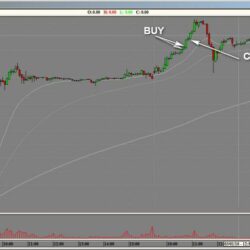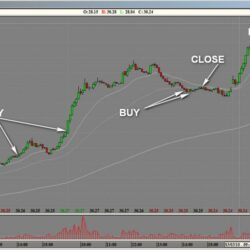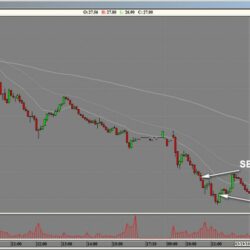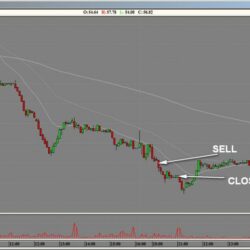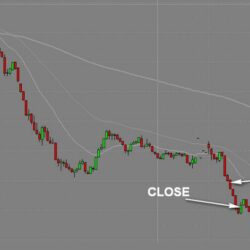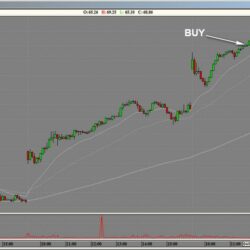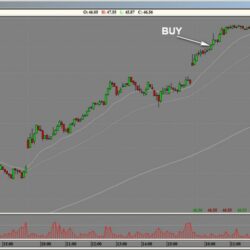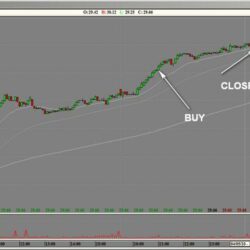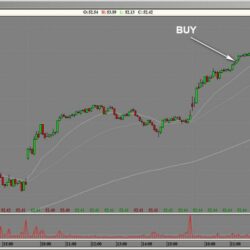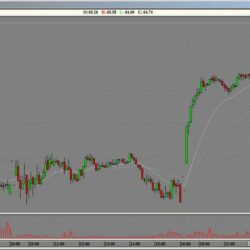
Trading strategy is a plan of action, which the trader used to make a profit in the financial markets. In this section, we will discuss the key aspects of the trading strategy on such exchanges, how NYSE (New York Stock Exchange), NASDAQ (National Association of Securities Dealers Automated Quotations) and AMEX (American Stock Exchange).
In the process of editing 21.10.2010 The essence of my trading strategy is simple, it is trading on the continuation of the trend or reversal of the stock within the day after a significant rise or fall.
The main signals for the continuation of the trend:
- On the daily chart stock must grow or pass a key level. Most often, I trade stocks that are on an annual high or have passed some significant level for 100 days.
- Look levels on the day and 15 minute scale, there should be a clear trend
- It is good if the volume rises on the daily chart
- Look smoothness of the action and her adequacy, so that there are no large shadows and some kind of sharp movements that are not understandable
- Pay attention to how it holds horizontal levels. The most important levels are usually figure, this is an even number (10$,11$,12$) second most important every 50C (10.50$ 11.50$ 12.50$) and every 25With (10,25$ 10,75$)
- I put stops behind these levels, or they hold well or I am already guided by the chart
- I try to enter the position in the area +-10C from levelI, no more. (For example, a stock rises and passes prices in 10$ i will try to get in the range 10.00-10.10 not higher, I rarely enter the level)
Examples :
- Drawing the bottom, in the form of a saucer, centerfold stock . Share must pass at least 2-3$ from the opening and trading in the afternoon such signals.
- Centerfold, after a strong climb stock and explosion Volume. Minimum 1$ must grow and starts at level abut.
Money management ( risk management) :
- If 3 days in the red, 4 I don't trade for a day.
- If 3-4 deals to the minus, rest for a while( min. 30 minutes )
- More 5 deals with O result, rest for a while( min. 30 minutes )
- I share the intraday loss limit :
- 60% from Limit I can lose before 12:00
- 40% from Limit I can lose after 14:00
- ON OPG I can lose depending on the position size, for each 1000 Shares ~ 7C loss.
Example: if I have a position 1000 shares then after an open loss in 70$ i will cover the position,
on 10 000 no more 800$ etc
- ON MOC already 10C on 1000 Shares , no more 1000$ on 10000 Shares
- STOP in all positions about 10C, but not more than 15C .
Research. Selecting stocks for trading on the NYSE
Watching news :
- RBC
- www.quote.ru/shares/today_news.shtml
- www.k2kapital.com
- briefing.com
- bloomberg.com
- www.plan.ru/
Economic numbers that will be released:
- www.briefing.com/Investor/Public/Calendars/EconomicCalendar.htm
During company reports , то Earnings Calendar :
- www.briefing.com/GeneralContent/Investor/Active/ArticlePopup/PagePopup.aspx?PageId=3270
Upgrades and Downgrades for shares:
- www.briefing.com/Investor/Public/Calendars/UpgradesDowngrades.htm
Technical selection of shares :
I select the shares that passed the most yesterday in dollars, minimum volume in shares 500K, traded on NYSE, 52 high or low
- finviz.with
- www.investertech.com
- stockcharts.com/def/servlet/SC.scan
- www.prophet.net/analyze/javacharts.jsp
So stock turns out 250-300, I am already taking them on schedule. As a result, it remains 20-30 stocks at best for trading and less, not counting the shares which are reported . Could forget something, if I will add something later.
Selecting stocks for trading on the NYSE
Research and selection of stocks for trading – This is a critical stage in your trading strategy. The right choice can be the basis of a successful transaction, unfaithful – cause of losses. That's why, Let's take a look at, how to effectively select stocks for trading on the New York Stock Exchange (NYSE).
1. Fundamental analysis
Fundamental analysis – This is the first and, perhaps, The most important stage in the selection of shares. It includes the study of the company's financial performance, such as profit, turnover, debt, as well as market capitalization. Besides, You should pay attention to the industry, in which the company operates, and the prospects for its development.
2. Technical analysis
Technical analysis is the study of stock price charts in order to identify trends and predict future price behavior. It involves the use of various indicators and patterns, such as moving averages, RSI, MACD and others.
3. News analysis
News analysis is also an important element in stock selection. This includes keeping track of relevant news, which can affect the share price, such as corporate reports, Economic news, political events, etc.
4. Risk assessment
The last stage in the selection of shares – risk assessment. This includes determining the level of risk, that you are willing to accept, and the selection of stocks with an appropriate level of risk.
Remember, that stock trading is always risky, And no strategy can guarantee 100% Success. But a competent approach to stock selection can significantly increase your chances of successful trading.
Superstitions, ritual
I'm not superstitious. I have no pre-trade rituals, if I notice any such things behind me, I immediately catch myself thinking and never repeat them. I have no happy things or objects, these are all superstitions and I isolate myself as much as possible from this. My success depends only on me, and not from signs or things.
Superstitions and rituals of traders
A very interesting topic is related to the superstitions and rituals of traders. Let's take a closer look at it.
Superstitious traders
Anyway, But many traders are subject to certain superstitions. Perchance, This is due to the psychology of trading, where individual rituals help maintain concentration and maintain emotional calm. Often these superstitions are individual in nature and can be related to the trader's personal life, his perception of the market, etc.
Rituals before the start of trading
No less important for traders are various rituals, which they make before the start of trading. Someone is used to starting the day with a certain kind of tea, Someone meditates before the opening of the trading session, And someone just looks at the news, To "feel" the market.
The influence of superstitions and rituals on trade
It is important to understand, that superstitions and rituals should not influence your trading strategy. Ultimately, Decisions to buy and sell shares should be based on objective analysis and common sense, and not on random rituals or premonitions.
but, If certain rituals help you focus on trading and make your trading process more comfortable, then why not? Main – Do not forget about the importance of objective analysis and common sense in making trading decisions.
so, What are your superstitions and rituals?? May be, You have a favorite cup of coffee, from which you drink before the opening of trading? Or you don't miss the morning yoga, to tune in to the upcoming trading session? We'd love to know
The first step in the formation of a trading strategy
1. Market research
The first step in forming a trading strategy is a thorough study of the market. This includes studying different indices (Dow Jones, S&P 500, NASDAQ Composite), understanding of major market trends and analysis of economic news, that can affect the market.
2. Determining the style of trading
The next step is to determine your trading style. You can be a long-term investor, Prefer “buy and hold” стратегию, or day trader, who conducts many trades throughout the day. Your trading style will determine the type of stock, that you choose, and time, that you spend trading.
3. Choosing stocks to trade
An important element of any trading strategy is the choice of stocks to trade. You can choose stocks based on fundamental or technical analysis, or use a combination of both approaches.
4. Management of risks
Risk management is a critical part of any trading strategy. You should always be prepared for possible losses and have a clear plan of action in case of adverse developments.
5. Continuous analysis and adjustment
Finally, A successful trading strategy requires constant analysis and adaptation. The market is constantly changing, And to maintain the success of your strategy, you need to be willing to continuously learn and adapt your strategy to changing conditions.
Recall, that trading in the stock markets involves risk. Don't invest more, What you can afford to lose, and always follow common sense and risk management.
Frequently asked Questions
1. What is the NYSE, NASDAQ и AMEX? These are the three largest U.S. exchanges, on which stocks are traded.
2. What is a trading strategy? Trading strategy – This is the trader's plan of action, Designed for the purpose of making a profit in the market.
3. What are the main elements included in a trading strategy? The main elements include trend analysis, stock selection, risk management and so on.
4. What are moving averages and how do they work?? Moving averages – It is a statistical tool, used to determine the average price of a stock over a certain period.
5. What is a stop loss and how does it work?? Stop loss – This is a pre-set price level, upon reaching which the trader closes the position, To avoid further losses.
6. What is portfolio diversification and why is it important?? Portfolio diversification – This is the distribution of investments between different assets in order to reduce risk.
7. What is the capitalization of the company and how does it affect the choice of stocks for trading? Capitalization of the company – This is the total market value of all its shares. Large-cap companies are considered more stable, But smaller companies can drive more growth.
8. How to choose stocks to trade on the NYSE, NASDAQ, and AMEX? The choice of stocks to trade depends on your strategy and analysis. Trends should be taken into account, branch, The company's financial performance and many other factors.
9. What is the risk associated with stock trading?? Stock trading is always risky. The stock price can fluctuate due to various factors, including economic conditions, the political environment and the level of investor confidence.
10. How can you manage risks when trading on the stock exchange?? A variety of strategies can be used, such as setting a stop loss, Portfolio diversification, selection of stocks with varying degrees of risk, etc.
11. What are trends in the stock market and how to analyze them? Trends – These are the directions of price movement in the stock market. Trend analysis helps predict future price behavior and make informed decisions.
12. What are the main trends now on the NYSE, NASDAQ, and AMEX? Trends are constantly changing. To answer this question, you should refer to the latest news and analytical reviews.
13. Which stocks are best for long-term investment? It depends on your investment strategy and risk profile. Usually, Long-term investors choose stocks of stable companies with good growth prospects.
14. What are short and long positions in stock trading?? Short position – This is the sale of borrowed shares with a view to their subsequent purchase at a lower price. Long position – This is the purchase of shares with a view to selling them at a higher price.
15. What are dividends and how do they affect stock trading?? Dividends – This is part of the company's profits, which is paid to shareholders. They can become an additional source of income for investors.
16. What is margin trading?? Margin trading – This is stock trading using borrowed funds.
17. What the ETF and how they are used in a trading strategy? ETF (exchange traded funds) – These are funds, traded on the stock exchange, as shares. They can be used to diversify a portfolio or to invest in specific industries or markets.
18. What is volatility and how does it affect stock trading?? Volatility – This is the degree of fluctuation in stock prices. High volatility can increase potential profits, but also increases the risk of loss.
19. What are the best indicators to use when analyzing trends in the stock market?? There are many indicators, including moving averages, relative strength index (RSI), MACD and others. The choice of indicator depends on your strategy and trading style.
20. What is an exchange-traded fund? (ETF) and how it works? Exchange traded fund (ETF) – This is a type of investment fund, whose shares are traded on the stock exchange, As regular shares. ETFs allow investors to invest in a portfolio of stocks, bonds or other assets.

